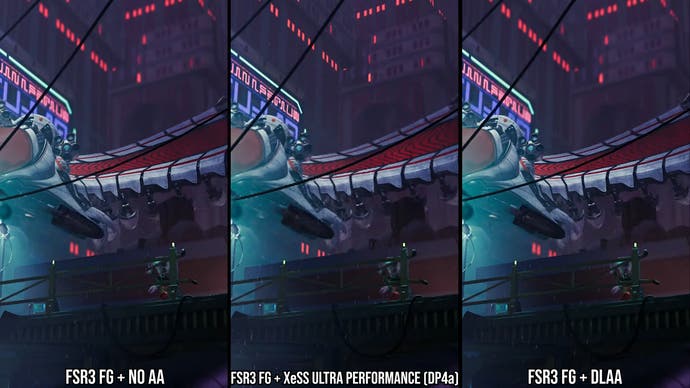AMD's FSR 3.1 upscaling tested: improved over FSR 2 but DLSS and XeSS are still ahead
Improvements are evident, but core issues remain.
Following the recent release of AMD's FSR 3.1 image reconstruction and frame generation technology, developer Nixxes has updated its recent Sony PC ports to add support for the new version. We've tested it to discover what improvements it offers over the initial offering and how FSR 3.1 compares to other image reconstruction techniques from Intel and Nvidia. Has the gulf in quality between machine learning-based solutions and the compute-driven FSR closed up? Is AMD now competitive?
The two promised major improvements to FSR 3.1 are straightforward to explain: the spatial temporal upscaler now produces higher-quality results, while the frame generation aspect is now decoupled from upscaling, allowing FSR 3 frame generation to be used with any image quality treatment (eg DLSS, XeSS or no AA at all). The latter is a great move, as it allows users of older RTX or Intel cards to benefit from frame generation while using their preferred image reconstruction technique.
Our focus today is on the improvements to image reconstruction, which are most obviously shown in the video embedded below. We selected 1440p balanced mode as it's the most interesting test case for image reconstruction and is the fastest-growing resolution for PC gaming as evidenced by the Steam Hardware Survey. We've seen quality issues with FSR's 1440p balanced mode in the past, especially in comparison to the largely excellent 4K quality mode, so it will be interesting to see whether AMD has made headway in this more challenging scenario.
As the Marvel's Spider-Man titles and Horizon: Forbidden West both use a dynamic time of day which can make comparisons difficult, we've opted to focus the bulk of our testing on Ratchet and Clank: Rift Apart and starting with a still camera shot, something that AMD specifically references in its blog post on the FSR 3.1 changes, it's clear that the previous version of FSR has room for improvement. One notable issue is that SSAO (screen space ambient occlusion) often appears to flicker. With FSR 3.1, this is indeed improved, with the flickering reduced - if not entirely eliminated - and the image appearing more stable over time.
Another improvement is evident where sunlight bouncing off of small metal elements in the ground, which causes flicker in FSR 2.2. This issue is subtly different than the previous example, as it's caused by the subpixel jittering inherent to FSR. (FSR samples from slightly different pixels each time, so one frame might include the point of sunlight, while the next might not. This causes the sunlight to be shown on alternate frames, leading to the flickering appearance.) Again, with FSR 3.1 the flicker still occurs, but its speed and intensity has been reduced, making it less obvious. We see similar improvements with background detail like trees, hand rails and building elements.
The same Ratchet and Clank shot also exhibits less pixelation in quickly-moving objects in FSR 3.1 versus 2.2, something we also noticed in FSR 3.1 previews of Horizon Forbidden West. Aliasing issues persist, but it's a tick better than it was before.

Another slight improvement is with some objects that lack motion vectors, such as the confetti falling from the sky in the same parade scene. Here the trails behind the individual pieces of confetti are reduced, though they're still undersampled and whispy in FSR 3.1 - making them almost disappear as a result. This can be shown with a comparison to 4x supersampling, where smaller individual confetti bits are visible with supersampling engaged but invisible with FSR.
Altogether, FSR 3.1 typically exhibits less subpixel flicker in still shots and less pixelation for objects in motion, though that difference is more slight and some particle effects lacking motion vectors disappear.
Elsewhere, other outstanding issues remain unsolved. RT reflections in Rift Apart continue to have flickering issues with the latest version of FSR, making the technique hard to recommend in many scenes with RT enabled. Most moving particles also exhibit a blocky look with obvious ghosting. The largest issue is still image stability, with edges that become aliased when moving, pixelation of certain elements and fizzles behind moving objects. Here, AMD is still noticeably behind the efforts of Nvidia and Intel.

When looking at FSR in comparison to XeSS and DLSS, it's clear that there's more fizzle occuring and the general look of aliasing changes frame-by-frame. This is due to a combination of elements: objects that move with FSR tend to have a blown-out pixelated look to them that is generally not well anti-aliased, making them look lower-res than the same objects with DLSS and XeSS. Disocclusion fizzle also remains with FSR 3.1, where areas uncovered by foreground movement exhibit oversharpening halos. This is visible frame by frame, and over time contributes to an impression that moving objects are lower resolution than static elements. It's a similar story with particles, which look to have nearly non-existent anti-aliasing and reconstruction, so they look very low resolution.
Particle effects show off a general issue that FSR 3.1 still exhibits: transparencies or anything without good motion vectors are seemingly bereft of improvements from FSR, while DLSS in contrast still manages to increase their resolution and prevent aliasing. Large objects tend to look more pixelated with FSR, while smaller objects such as the confetti can disappear altogether - something that doesn't happen with either XeSS or DLSS.
Other objects that lack good motion vectors show similar issues, such as Ratchet and Clank's diagetic HUD elements. For example, weapon buy menus are projected onto a surface in the world, and FSR has trouble differentiating between the 3D element and the surface it is on, leading to a smeared and aliased result. By comparison, DLSS does manage to provide good anti-aliasing and lacks that smeared look.
This comparison to XeSS, or in particular DLSS, shows that FSR 3.1 still has room for improvement. Even areas of FSR 3.1 that improved, such as still image stability, still don't match what's possible with DLSS and XeSS. Core issues therefore remain, encapsulating moving objects, revealed backgrounds, objects lacking motion vectors, particles, and more.
As these issues were evident from the first showings of FSR 2 over two years ago and still have not been solved, despite not being evident in competing techniques, it's clear that there's potential for more substantial FSR changes. Perhaps a change in technique is warranted, with the machine learning used by Intel and Nvidia being an obvious avenue for exploration. Given how Sony is reportedly using machine learning for their PSSR image reconstruction on PS5 Pro, it seems like they got the memo. Beyond this, Epic's work with TSR shows that machine learning isn't an absolute requirement for good upscaling results, so perhaps AMD can draw some inspiration from Epic's techniques in the meantime.
Based on our testing, while FSR 3.1 has improvements over the previous version, particularly in terms of detail stability while the camera is still, core issues unfortunately remain. Ultimately, I think the technique needs to be advanced in a new direction, as proven by rival offerings XeSS and DLSS, if AMD wants to remain competitive in this space. As things stand, the hierarchy of quality persists: FSR at the bottom, XeSS in the middle and DLSS at the top.




.jpg?width=291&height=164&fit=crop&quality=80&format=jpg&auto=webp)





